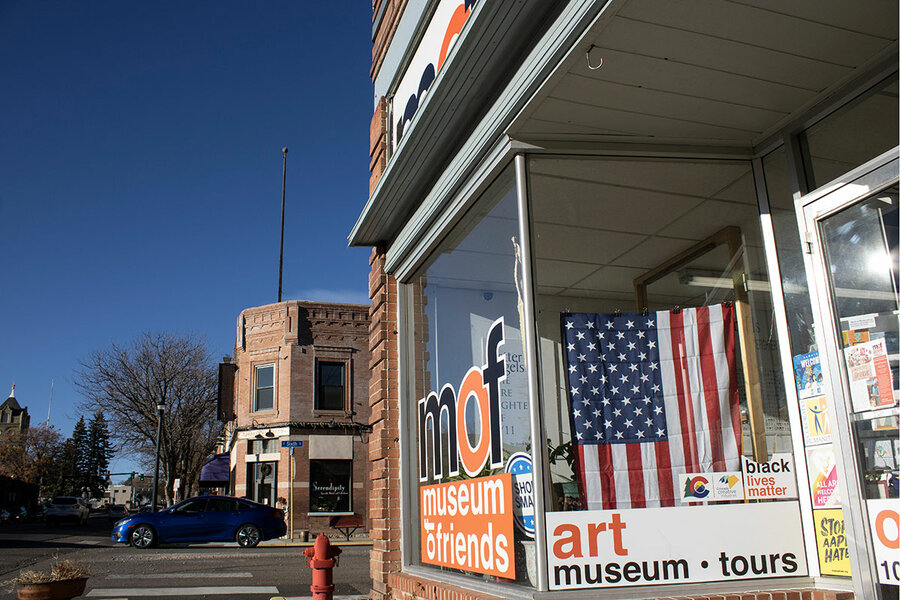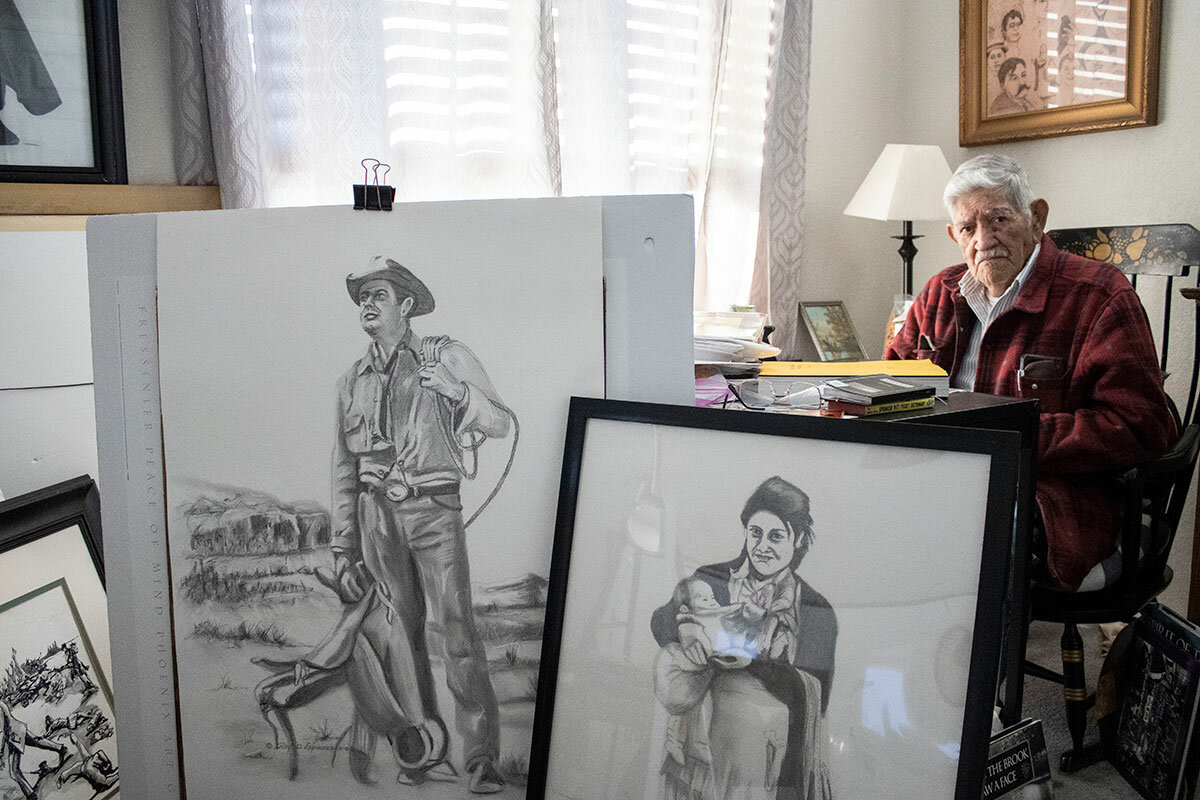At Colorado’s Museum of Friends, art is priceless – literally
Loading...
| Walsenburg, Colo.
In Walsenburg, a former coal mining town in southern Colorado, tumbleweeds tangle with leaves on the sidewalk. Winds of change have also swept through a century-old brick building on Main Street that for decades housed a JCPenney. Today, a pair of East and West Coasters has transformed it into a contemporary art museum, its walls a crisp gallery white.
Artists Brendt Berger and Maria Cocchiarelli-Berger traipse through their Museum of Friends (MoF), where artworks hang cozily close, floor to ceiling, salon-style. In this memory palace of their making, each piece conjures reflections of the artist – many of whom have donated their work. On their umpteenth tour, they’re still kids in a candy shop.
“The ones that have the story” are favorites of Ms. Cocchiarelli-Berger, who gushes about a colorful painting hung up high. It recalls a friend’s view of the Brooklyn waterfront, since obscured by a seafood eatery. Mr. Berger zooms in on a line drawing of straight, meditative marks.
Why We Wrote This
A story focused onMoney doesn’t play a deciding role in what these artists collect. Instead, their contemporary art museum in southern Colorado operates on what they call “soul value.”
“It like breathes, the lines do,” he says, fingers hovering above them.
The couple held a grand opening for MoF in 2007, shortly after their marriage that followed a yearslong friendship. The nonprofit, a self-described counterculture art museum, prizes freedom of expression and inclusive community, and has works by Dennis Oppenheim and Yoko Ono along with those by local artists.
MoF sets itself apart from the larger art world by erasing money as an arbiter of worth, says Mr. Berger. Rather than the economic value of an artwork, the founders embrace its “soul value.”
“We build community,” he says. “We try to do it in a personal way that acknowledges the uniqueness and the richness of each human being.”
Avoiding the “gallery system”
Walsenburg, a town of some 3,000 residents backdropped by the Spanish Peaks, has tried to rebrand in recent years, reports Colorado Public Radio. The museum is part of that transformation, linked to a regional renaissance of art enclaves. State-certified “creative districts” include Trinidad to the south and La Veta to the west, where Mr. Berger and Ms. Cocchiarelli-Berger reside. The state is also one of the nonprofit’s grant funders.
This isn’t the first time Mr. Berger has tried to sidestep money’s traditional role in the art world.
In the late 1960s, Mr. Berger, a Californian, visited Libre, a southern Colorado artist community co-founded by his friend Dean Fleming. Beyond working as an artist and teacher, Mr. Berger organized artists “to circumvent the gallery system,” which tends to focus on pieces that will sell. He also lobbied for a federal art bank that would support creators by buying or leasing their work. Though the art bank never materialized, he sees MoF as an “extension of a lot of those ideas.”
The pair met in New York City through an art show in the ’80s, then reunited there in the early 2000s. A mutual friend suggested she reach out to Mr. Berger for some repairs on her mother’s house.
“I picked him up with his little toolbox, because he didn’t have a car,” she recalls. “The rest is history.”
Brooklyn-born artist and educator Ms. Cocchiarelli-Berger, a bundle of energy with close-cropped red hair, is the executive director and tackles the planning and fundraising. She’s also the head chef at home.
Mr. Berger, of more West Coast tempo, sports an electric-blue shirt. As president of the board of directors, he oversees curation and correspondence. At home, says his wife, “he cleans up after me.”
Several hundred works of art received from artist friends over the years helped establish a permanent collection, which now totals some 1,600 pieces. The ground floor has a Made in Walsenburg gift shop, changing exhibitions, and space for education programs. Upstairs is more intimate and painting-packed, a series of rooms that open onto other rooms. One brims with artifacts linked to Mr. Berger’s Hawaiian ancestry.
A support to the local community
The museum, which holds tours for a suggested donation of $8 for adult nonmembers, has received around 3,000 visitors this year. And despite its focus on “soul value,” MoF brings money into the town. Ms. Cocchiarelli-Berger says museum visitors help enliven the economy of Huerfano County, whose median household income of $45,724 is a little over half that of the state. Event guests seek lodging, she says, and the museum’s artists-in-residence buy groceries.
“My philosophy is not that capitalism is bad,” she says. “The arts are an incredible economic driver.”
“They do a fantastic job,” says Nancy Lave across the street at her shop, Main Street Antiques. “They’re really into what they’re doing and they love it.”
For Denver area artist Ray Espinoza, having work hang in his hometown is meaningful.
“I’m one of the sons of Walsenburg, and I wanted to have something there for posterity,” he says. The Marine veteran is a self-described “all-around artist,” whose work spans sculpture, paintings, music, poetry, and protest posters for the Chicano movement.
The founders plan to hold onto MoF for only so long. They hope another entity will have taken over by 2027 – perhaps a university, philanthropist, or another museum. “We would like to be able to make art again,” Ms. Cocchiarelli-Berger says.
Till then, the art of friendmaking continues. After a November interview, Mr. Berger followed this reporter out the door. He offered to photograph me in front of the museum – not on his camera, but mine.
Why not, I thought. A moment worth collecting.








